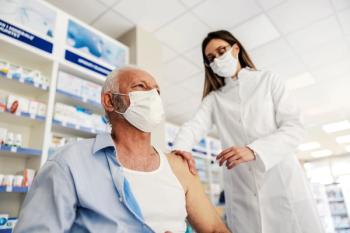
Give it your best shot: Four simple tips for vaccinators
As a faculty trainer for the American Pharmacists Association’s Pharmacy-Based Immunization Delivery certification program and a pharmacist who offers immunizations, I have trained hundreds and vaccinated thousands of individuals. Here are some tips and experiences that will hopefully be beneficial to pharmacists in any setting who want to immunize patients.
As a faculty trainer for the American Pharmacists Association’s Pharmacy-Based Immunization Delivery certification program and a pharmacist who offers immunizations, I have trained hundreds and vaccinated thousands of individuals. Here are some tips and experiences that will hopefully be beneficial to pharmacists in any setting who want to immunize patients.
Talk to your patients
It is easy to get in the habit of giving the patient’s questionnaire a quick glance, noting no issues, and proceeding to vaccination. Instead, stop and ask your patient a few questions that may not be on your screening questionnaire. Even a “How are you doing today?” can go a long way.
Consider that the patient may have just glanced at the questions and did not take the time to carefully read them. Ask your patient, “Do you have any questions? Have you had this vaccine before? Are you allergic to anything?” If the patient asks why you are asking again, just let the patient know that you want to be sure there is nothing to prevent the patient from receiving the vaccine in question. Safety first.
If the person has previously received the vaccine, the patient has an opportunity to tell you about any previous reactions or to comment about any sickness it may have caused. You now have another opportunity to: 1) verify that the vaccine is not contraindicated, 2) verify that the patient does need another dose of the vaccine based on current recommendations1, 3) correct any vaccine misconceptions that were expressed, and/or 4) educate the patient about common vaccine-related reactions and what to do if they occur.
What most people don’t realize is that this brief question-and-answer period is more than just fact checking. Listening to how your patient speaks and watching body language will give you a good indication of how nervous your patient is. A tight-lipped patient who won’t look at you when you are conversing is a dead giveaway. Many patients will take this time to ask questions about the vaccine or inform you about their fear of needles.
Trust a patient who tells you about passing out when receiving shots or when blood is drawn. I have had patients (and students) who will pass out at the very sight of a needle. At least once a year I give a flu shot to a patient lying on the ground to avoid any injury from falling out of a chair. I have a good deal of empathy for patients with a heightened vasovagal reflex or fear of needles. I used to be one of them and I know how reluctant I was to get vaccinated because of it. Staying calm and confident throughout the process will avail, or at least attenuate, a patient’s jitters.
If you have a concerned patient who presents you with a litany of allergies, take the time to get the package insert (PI) for the vaccine in question. Show them the ingredients that are listed in the “DESCRIPTION” section of the PI (section 11 of any PI). Also, check for latex allergies if the vaccine container has a latex stopper (typical of pre-filled syringes; listed in PI section 16 “How Supplied/Storage and Handling”). Some patients will even react to latex gloves or bandages. The last thing anyone would want is redness near the injection site from a latex bandage and to misinterpret it as an injection site reaction or worse, the beginning of an allergic reaction to the vaccine. I only stock latex-free supplies for this very reason.
Sit back and relax
Ask your patients to “sit back, relax, and enjoy the show.” If you don’t get a reaction, go back three paragraphs. Ask your patient to sit back in the chair and relax as much as possible. For intramuscular injections in the deltoid, have the patient rest the arm you will be injecting at the side and place the hand palm up on his or her lap. This will disengage the deltoid muscle more than resting the arm on an armrest, dangling it at his or her side, or in some cases trying to flex the muscle to “help” you see where the muscle is.
The deltoid can be hard to find in some patients. If it is, place your hand on the outer side of his or her elbow and ask the patient to laterally raise the arm thus pushing against your hand. With your other hand, you can easily palpate the deltoid muscle.
I mention this because I have seen many patients who received injections in the middle of their arm in line with their triceps muscle who claim to have received an intramuscularly administered vaccine (e.g., influenza). Incorrect administration may decrease vaccine effectiveness, so make sure you know you are administering it in the right tissue/location. Vaccines administered incorrectly may need to be re-administered via the correct route. If you are unsure about revaccination, go to the Advisory Committee on Immunization Practices (ACIP) Recommendations page on the Centers for Disease Control and Prevention (CDC) website.1
Good positioning is recommended for the vaccinator as well. Before you unsheathe the syringe, make sure your patient is in a convenient position for you to deliver the injection and dispose of the syringe once completed (in addition to activating the safety device). Failure to have your supplies and sharps container in a convenient location can result in you fumbling for a bandage, scrambling for a cotton ball to stop a bleed, or even sticking yourself with a used syringe prior to disposal.
Don’t go off course
Follow what is generally taught for all injections: after the injection, activate the safety device and dispose of the syringe in a sharps container. Nothing else should occur prior to the needle disposal. Your eyes should not leave the needle until it is disposed of properly.
I have watched vaccinators activate the safety device and place the syringe in a prescription tote, on the ground, or a countertop prior to disposal. I have also had safety devices fail to activate. The combination of the two could lead to a life-altering needle stick injury.
“Aren’t you watching the patient in case they pass out after the shot?” Proper injection technique includes having a hand on your patient while you are injecting and disposing of the syringe. So if the patient faints, you have a hand on the patient’s arm/shoulder and can keep the patient in the seat. I don’t worry about patients fainting. I worry about what they will hit on the way down or that the floor will catch them if I have not correctly positioned myself and held them in the seat.
“What if the patient starts to bleed?” Activate the safety device, dispose of the syringe, and then deal with the blood dripping down the patient’s arm. Most patients will not bleed following a correctly administered vaccine. If they do, the source is just a superficial capillary. The chances of bleeding are increased if your patient is warm or flushed (increased blood flow to the peripheral capillaries in the skin) or if the patient’s sleeve has been tightly rolled up on the arm. It just means that you need to have your cotton ball that much more at the ready… after your syringe is disposed of properly.
Be prepared
All immunization protocols should contain a section about adverse reactions following the receipt of a vaccination. If your protocol does not, it is time for a new protocol. This and other great information is available for free on the Immunization Action Coalition’s website, http://www.immunize.org/clinic/administering-vaccines.asp.2
Have you read your protocol? Do you have it posted somewhere convenient or readily available should you need it? Do you have all the medications that it outlines?
The first medication included within the emergency protocol is epinephrine, many times in the form of an Epi-pen. While most pharmacies have this in stock, does your pharmacy have a separate supply for your emergency kit that includes at least three adult Epi-pens®, as recommended?2
I recommend creating a small supply kit that is always within reach of the vaccinator. This kit should include the general injection supplies (e.g., bandages, alcohol swabs, etc.), a sharps container, and emergency supplies.
If you are in a community pharmacy and must vaccinate in the waiting area, the kit should be with you. You don’t want to leave the patient to get an emergency medication or have to yell to other pharmacy personnel for help. Leaving the patient for even a forgotten bandage appears amateur and unprofessional. Be prepared and be professional.
References
1. http://www.cdc.gov/vaccines/recs/default.htm
2.
Mark P. Walberg, PharmD, PhD, is assistant professor of pharmacy practice, University of the Pacific Thomas J. Long School of Pharmacy and Health Sciences, Stockton Calif.
Newsletter
Pharmacy practice is always changing. Stay ahead of the curve with the Drug Topics newsletter and get the latest drug information, industry trends, and patient care tips.






































































































































